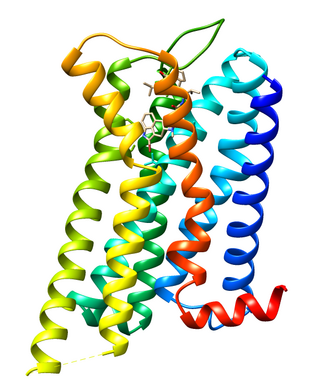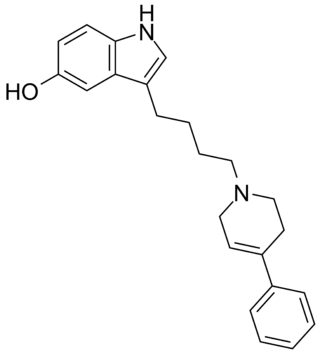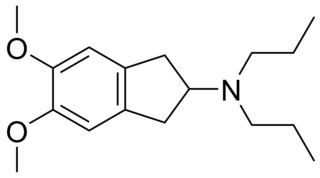
Restless legs syndrome (RLS), also known as Willis-Ekbom disease (WED), is generally a long-term disorder that causes a strong urge to move one's legs. There is often an unpleasant feeling in the legs that improves somewhat by moving them. This is often described as aching, tingling, or crawling in nature. Occasionally, arms may also be affected. The feelings generally happen when at rest and therefore can make it hard to sleep. Due to the disturbance in sleep, people with RLS may have daytime sleepiness, low energy, irritability and a depressed mood. Additionally, many have limb twitching during sleep. RLS is not the same as habitual foot-tapping or leg-rocking.

Cabergoline, sold under the brand name Dostinex among others, is a dopaminergic medication used in the treatment of high prolactin levels, prolactinomas, Parkinson's disease, and for other indications. It is taken by mouth.
Neuropharmacology is the study of how drugs affect function in the nervous system, and the neural mechanisms through which they influence behavior. There are two main branches of neuropharmacology: behavioral and molecular. Behavioral neuropharmacology focuses on the study of how drugs affect human behavior (neuropsychopharmacology), including the study of how drug dependence and addiction affect the human brain. Molecular neuropharmacology involves the study of neurons and their neurochemical interactions, with the overall goal of developing drugs that have beneficial effects on neurological function. Both of these fields are closely connected, since both are concerned with the interactions of neurotransmitters, neuropeptides, neurohormones, neuromodulators, enzymes, second messengers, co-transporters, ion channels, and receptor proteins in the central and peripheral nervous systems. Studying these interactions, researchers are developing drugs to treat many different neurological disorders, including pain, neurodegenerative diseases such as Parkinson's disease and Alzheimer's disease, psychological disorders, addiction, and many others.

Ropinirole, sold under the brand name Requip among others, is a medication used to treat Parkinson's disease (PD) and restless legs syndrome (RLS). In PD the dose needs to be adjusted to the effect and treatment should not be suddenly stopped. It is taken by mouth.

Pramipexole, sold under the brand Mirapex among others, is medication used to treat Parkinson's disease (PD) and restless legs syndrome (RLS). In Parkinson's disease it may be used alone or together with levodopa. It is taken by mouth. Pramipexole is a dopamine agonist of the non-ergoline class.

A dopamine agonist(DA) is a compound that activates dopamine receptors. There are two families of dopamine receptors, D2-like and D1-like, and they are all G protein-coupled receptors. D1- and D5-receptors belong to the D1-like family and the D2-like family includes D2, D3 and D4 receptors. Dopamine agonists are primarily used in the treatment of Parkinson's disease, and to a lesser extent, in hyperprolactinemia and restless legs syndrome. They are also used off-label in the treatment of clinical depression. The use of dopamine agonists is associated with impulse control disorders and dopamine agonist withdrawal syndrome (DAWS).

Rotigotine, sold under the brand name Neupro among others, is a dopamine agonist of the non-ergoline class of medications indicated for the treatment of Parkinson's disease and restless legs syndrome. It is formulated as a once-daily transdermal patch which provides a slow and constant supply of the drug over the course of 24 hours.

Piribedil (trade names Pronoran, Trivastal Retard, Trastal, Trivastan, Clarium and others) is an antiparkinsonian agent and piperazine derivative which acts as a D2 and D3 receptor agonist. It also has α2-adrenergic antagonist properties.

Dihydroergocryptine (DHEC), sold under the brand names Almirid and Cripar among others, is a dopamine agonist of the ergoline group that is used as an antiparkinson agent in the treatment of Parkinson's disease. It is taken by mouth.

Dopamine receptor D2, also known as D2R, is a protein that, in humans, is encoded by the DRD2 gene. After work from Paul Greengard's lab had suggested that dopamine receptors were the site of action of antipsychotic drugs, several groups, including those of Solomon Snyder and Philip Seeman used a radiolabeled antipsychotic drug to identify what is now known as the dopamine D2 receptor. The dopamine D2 receptor is the main receptor for most antipsychotic drugs. The structure of DRD2 in complex with the atypical antipsychotic risperidone has been determined.

Dopamine receptor D1, also known as DRD1. It is one of the two types of D1-like receptor family - receptors D1 and D5. It is a protein that in humans is encoded by the DRD1 gene.

Dopamine receptor D3 is a protein that in humans is encoded by the DRD3 gene.

Aplindore (DAB-452) is a drug which acts as a partial agonist selective for the dopamine receptor D2. It is being developed by the pharmaceutical company Neurogen as a treatment for Parkinson's disease and restless legs syndrome.

Pimavanserin , sold under the brand name Nuplazid, is an atypical antipsychotic which is approved for the treatment of Parkinson's disease psychosis and is also being studied for the treatment of Alzheimer’s disease psychosis, schizophrenia, agitation, and major depressive disorder. Unlike other antipsychotics, pimavanserin is not a dopamine receptor antagonist.

Ecopipam is a dopamine antagonist which is under development for the treatment of Lesch-Nyhan syndrome, Tourette's syndrome, speech disorders, and restless legs syndrome. It is taken by mouth.

A-86929 is a synthetic compound that acts as a selective dopamine receptor D1 agonist. It was developed as a possible treatment for Parkinson's disease, as well as for other applications such as treatment of cocaine addiction, but while it had reasonable efficacy in humans it also caused dyskinesias and has not been continued. It has mainly been used as its diacetate ester prodrug adrogolide (ABT-431), which has better bioavailability.

Roxindole (EMD-49,980) is a dopaminergic and serotonergic drug which was originally developed by Merck KGaA for the treatment of schizophrenia. In clinical trials its antipsychotic efficacy was only modest but it was unexpectedly found to produce potent and rapid antidepressant and anxiolytic effects. As a result, roxindole was further researched for the treatment of depression instead. It has also been investigated as a therapy for Parkinson's disease and prolactinoma.

PNU-99,194(A) (or U-99,194(A)) is a drug which acts as a moderately selective D3 receptor antagonist with ~15-30-fold preference for D3 over the D2 subtype. Though it has substantially greater preference for D3 over D2, the latter receptor does still play some role in its effects, as evidenced by the fact that PNU-99,194 weakly stimulates both prolactin secretion and striatal dopamine synthesis, actions it does not share with the more selective (100-fold) D3 receptor antagonists S-14,297 and GR-103,691.

CY-208,243 is a drug which acts as a dopamine agonist selective for the D1 subtype. Unlike most D1-selective agonists, it shows efficacy in animal models of Parkinson's disease.

OSU-6162 (PNU-96391) is a compound which acts as a partial agonist at both dopamine D2 receptors and 5-HT2A receptors. It acts as a dopamine stabilizer in a similar manner to the closely related drug pridopidine, and has antipsychotic, anti-addictive and anti-Parkinsonian effects in animal studies. Both enantiomers show similar activity but with different ratios of effects, with the (S) enantiomer (–)-OSU-6162 that is more commonly used in research, having higher binding affinity to D2 but is a weaker partial agonist at 5-HT2A, while the (R) enantiomer (+)-OSU-6162 has higher efficacy at 5-HT2A but lower D2 affinity.



















